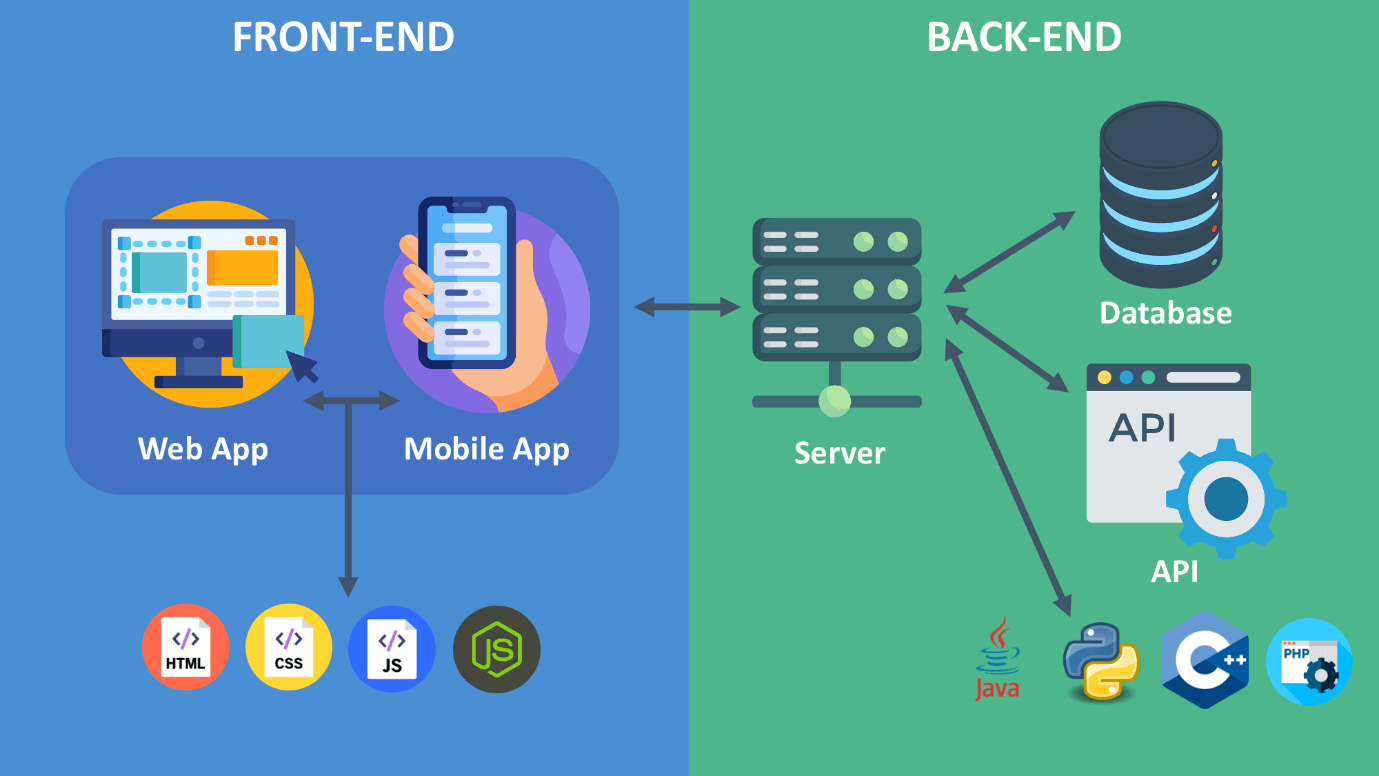Demystifying the Web:
Understanding Front End, Back End, Database, and APIs

In the dynamic world of web development, understanding the intricate dance between various components is crucial for creating seamless and interactive digital experiences. At the heart of this process are four key elements: Front End, Back End, Database, and APIs. In this blog post, we’ll embark on a journey to unravel the mysteries behind these components and explore how they come together to power the websites and applications we use every day.
Front End: The Face of the Web

The Front End, also known as the client side, is what users interact with directly. It encompasses everything a user sees and interacts with on a website or application. This includes the layout, design, buttons, forms, and any other visual elements. Technologies like HTML, CSS, and JavaScript are the building blocks of the Front End, enabling developers to create engaging and responsive user interfaces.
Technologies
- HTML: Hypertext Markup Language (HTML) lays the foundation of every web page. It’s the structural backbone, defining the hierarchy of content elements. From headings and paragraphs to images and links, HTML structures information, creating a blueprint for browsers to interpret. Developers harness its power to craft the skeletal structure of websites, ensuring accessibility and clarity in content presentation.
- CSS: Cascading Style Sheets (CSS) is the artistic touch, bringing life and vibrancy to the digital canvas. It’s the styling maestro, responsible for layout, color schemes, and visual aesthetics. With CSS, developers mold the HTML structure into a visually appealing masterpiece, ensuring responsiveness across devices. From intricate animations to responsive grids, CSS transforms static content into dynamic, visually captivating experiences.
- JavaScript: JavaScript is the dynamic force that breathes life into web applications. As a versatile scripting language, it adds interactivity and responsiveness. Front-end developers leverage JavaScript to create dynamic user interfaces, handle user input, and fetch data asynchronously. With the rise of frameworks like React and Vue.js, JavaScript has evolved into a robust tool for building modern, interactive web applications, enhancing the user experience with seamless and engaging functionality.
Back End: The Architectural Backbone

While the Front End handles the user interface, the Back End, or server side, is the behind-the-scenes engine that powers the functionality. It deals with server management, application logic, databases, and user authentication. Common Back End languages include Python, Ruby, Java, and PHP. The Back End ensures that data is processed, stored, and delivered efficiently to the Front End.
Technologies
- Node.js: Node.js, built on the V8 JavaScript runtime, revolutionizes back-end development with its non-blocking, event-driven architecture. Ideal for real-time applications, Node.js handles concurrent connections seamlessly. Its extensive package ecosystem (npm) and single-language proficiency from front to back make it a go-to choice for developers seeking scalability and performance in applications, from APIs to microservices.
- Python: Python’s readability and versatility extend seamlessly to the back end. With frameworks like Django and Flask, Python simplifies complex tasks, fostering rapid development. Python excels in data handling, making it a preferred choice for web applications, APIs, and data-centric projects. Its robust ecosystem and community support ensure a smooth development journey, empowering developers to focus on creativity rather than boilerplate code.
- Ruby: Ruby, known for its elegant syntax and developer-friendly environment, has a thriving backend ecosystem. Ruby on Rails, a powerful web application framework, emphasizes convention over configuration, streamlining development. With built-in features like ActiveRecord for database interactions, Ruby enables developers to create robust and maintainable applications with speed and elegance.
- PHP: PHP, a stalwart in web development, continues to evolve as a reliable backend solution. With frameworks like Laravel and Symfony, PHP empowers developers to build scalable and secure web applications. Its broad adoption, vast community, and integration capabilities make PHP a top choice for content management systems, e-commerce platforms, and dynamic websites, showcasing its enduring relevance in the ever-changing tech landscape.
Database: The Information Repository

A database is like the digital brain of a web application. It’s where data is stored, organized, and retrieved. Databases come in various forms, such as relational databases (like MySQL and PostgreSQL) and NoSQL databases (like MongoDB and Cassandra). The database is crucial for storing user information, content, and other data that the application relies on. The Back End interacts with the database to fetch or update information as needed.
API: Bridging the Communication Gap

API, or Application Programming Interface, acts as a bridge between different software systems. It allows the Front End and Back End to communicate seamlessly. APIs define the methods and data formats that applications can use to request and exchange information. With APIs, developers can integrate third-party services, connect different parts of an application, or even enable communication between entirely separate applications.
Bringing It All Together
The magic of web development happens when these components work harmoniously. A user interacts with the Front End, triggering requests that are sent to the Back End. The Back End processes these requests, communicates with the Database to fetch or update information, and uses APIs to connect with external services. The result is a dynamic and interactive user experience.
Conclusion
In the ever-evolving landscape of web development, a solid understanding of Front End, Back End, Database, and APIs is fundamental. Each component plays a unique role in creating the digital experiences we encounter daily. Aspiring developers and tech enthusiasts alike can benefit from grasping the interplay between these elements, unlocking the potential to create powerful and efficient web applications that captivate users worldwide.
